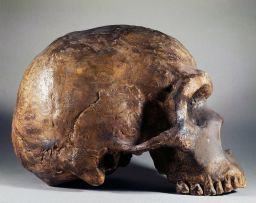Forget those brutish caveman grunts. Neanderthals, our closest ancestors, could have produced the same sounds as humans today, according to a study modeling the hearing ability of the Stone Age hominins that went extinct about 40,000 years ago.
Whether Neanderthals, and other human ancestors, were capable of sophisticated spoken language has been a topic of long-standing debate in human evolution.
New research published on Monday suggests that Neanderthals had a vocal communication system that could have been similar to human speech.
“Neandertals could have produced all the sounds in that frequency range, like we can. There does not seem to be any difference in their ability to produce speech sounds. So they definitely could have said ‘hello’ or ‘ok’ if those utterances had any meaning for them,” said Rolf Quam, an associate professor and director of the evolutionary studies program at Binghamton University in New York, in an email.
Studying the evolution of language is notoriously tricky, the researchers said, given that the soft tissue that forms brains and vocal tracts isn’t preserved in the fossil record. Fortunately, bones that form the hearing system have been preserved.
With the help of CT scans, the team made 3-D models to reconstruct how Neanderthals heard by using information from the fossilized ear structures of several Homo sapiens, Neanderthals and earlier fossils from a group of hominins thought to be the ancestors of Neanderthals.
They used this information to reverse-engineer how they may have communicated.
Consonants
Quam said the research was “the first comprehensive study of Neandertal auditory capabilities” and considered over 30 variables, including the ear canal, ear drum, the ear bones and air-filled spaces in the ear.
They were able to measure how the energy in sound travels from the surrounding environment through the ear canal, to the ear drum, through the tiny middle ear bones until it reaches the inner ear – a process called sound power transmission.
This information helped the team calculate the occupied bandwidth, which is the range of frequencies in which at least 90% of the sound energy reaches.
This is the “frequency range we hear best in,” Quam explained. “We still hear sounds outside of this range, but this range is kind of the ‘sweet spot’ where our ear is most tuned to sounds.”
They found that the bandwidth of Neanderthals was greater than the older hominin population. It was very similar to living humans and would have encompassed most of the sounds emitted in the human language.
The research, published in the journal Nature Ecology & Evolution, suggested that Neanderthal speech would have involved an increased use of consonants – a vocal signal that separates human speech and language from the communication patterns in other primates, which are able to make vowel sounds.
Complex lives
Many researchers now assume that Neanderthals had complex lives and would have developed the capacity for speech, said Chris Stringer, research leader in human origins and professor at the Natural History Museum in London.
Recent archeological finds suggest that they wore jewelry, produced art and had their own rituals – suggesting they were capable of symbolic thought and the cognitive equals of early modern humans.

“Whether they had languages as complex as ours is not something that can be determined from this research as language is a product of the brain, not the vocal and hearing systems,” said Stringer, who wasn’t involved in the study.
Alexander Stoessel, an evolutionary biologist at Friedrich Schiller University Jena in Germany who studies acoustic communication, said he largely agreed with the conclusions of the research. But Stoessel, who was not involved in the study, noted their models had made assumptions about the “soft tissue parameters” in the ear – something that can strongly influence sound transmission.
Neanderthals and early Homo sapiens lived in some of the same places and likely encountered each other over a period of thousands of years before we emerged as the lone hominin survivor. Sometimes they had children – the evidence is in our DNA. Could they have chatted with one another?
“It’s hard to communicate with people from my neighboring countries. I doubt that they spoke the same language but I think they were able to communicate one way or another,” said Stoessel.
“They had sex with each other so some kind of communication was probably likely.”





